I know I don’t often dabble in editorial content here on Cerealously, so feel free to ignore this if you’re only here for reviews. I just wanted to finally give a long-form answer to a question I’ve been asked a lot recently:
“What do you think about the future of breakfast cereal?”
There’s little doubt that cereal is at a crossroads. Between an increasingly health-conscious society, claims of “lazy millennial breakfasters,” and longer work hours that require on-the-go meals, it’s becoming harder and harder for some to justify a dazzling rainbow bowl of Froot Loops at 5:00 A.M.
Kellogg’s and General Mills: Evolving Cereal in an Evolving World
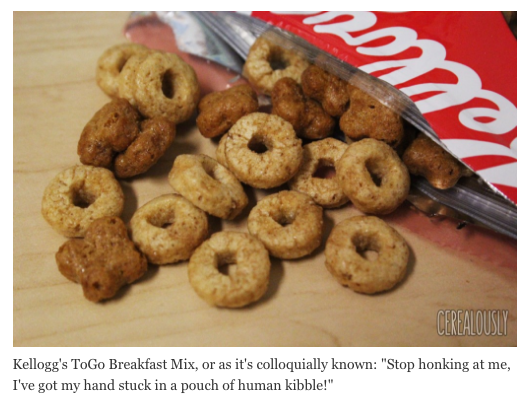
Big Cereal has responded in different ways. Despite their maddening use of the overused term “soggy sales” (it’s not clever any more, guys), Adweek did an interesting analysis of Kellogg’s and General Mills’ competing responses to America’s great cereal shift.
Kellogg’s has tried to reinvent the traditional idea of cereal as best as possible. With new products like Raisin Bran Granola and Kellogg’s ToGo Breakfast Mixes, the slurp-able bowl with milk that we once knew is becoming something we can fit in our cupholder and munch at 70 miles per hour. Kellogg’s is even embracing underground cereal eating trends, as their recently opened NYC cereal café combines hipster recipe remixes with the nostalgic and campy aesthetic of Saturday morning cartoons with cereal.
I’m not the first to notice that this move is a little ironic on Kellogg’s part; a big corporation co-opting a movement that’s all about never growing up sounds like a concept straight out of a color-charged Pixar movie (The Guardian has an enlightening read on cereal cafés). But having never visited Kellogg’s NYC, I’ll refrain from adult cynicism because I, too, am an innocent and trusting kid at heart.
Flipping the breakfast table over to General Mills—the magically delicious minds behind Lucky Charms and Cocoa Puffs—we see a trend towards healthification: a term I just pulled out of my pot o’ gold to explain why we’re currently seeing cereals like “All Natural Organic Protein Cluster Kale Chia Flax Flakes with Activated Almonds” spreading their corn syrup-free roots across the breakfast aisle.
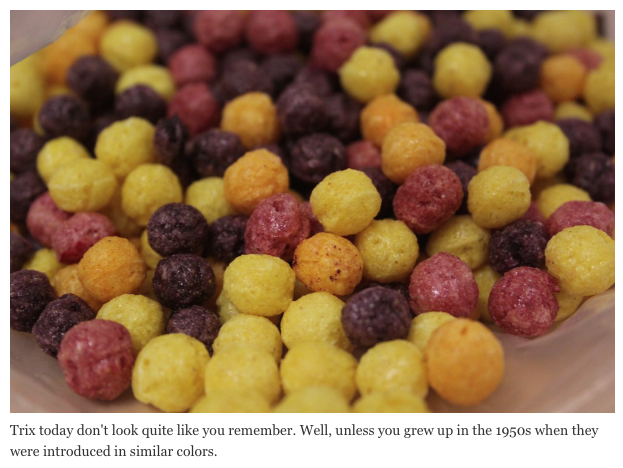
Some people think artificial ingredients in cereal are inherently bad, and whether you think it’s a sound argument or not (“Momma always said if you have nothing nice to say…”), this opinion is having an impact. General Mills has vowed to remove artificial colors and flavors from as many of their cereal offerings as possible, while many Cheerios varieties are going gluten-free.
As a cereal nostalgia junkie, this isn’t my preferred choice. Eating muted, artificial color-free Trix makes my inner flame of childhood glow a little dimmer. But I suppose I can’t be too upset: this move increased General Mills’ Q1 2016 sales, hopefully signaling the end of a long cereal slump.
Of course, these aren’t the only battle tactics Kellogg’s and General Mills are using against their naysayers. From Kellogg’s “Good Night Snack” campaign emphasizing cereal as a nighttime food to General Mills’ Lucky Charms All Marshmallows contest and Cinnamon Toast Crunch Selfie Spoon, there are still constant pangs of youthful whimsy in cereal advertising.
This silliness, I believe, is what cereal’s future truly relies on: not changing what cereal is, or changing what’s in cereal. Kellogg’s and General Mills need to use cereal as the nostalgic touchstone so many see it as, complete with zany colors, games on the back of the box, and hilarious exaggerated cartoon characters.
And what so many have failed to notice is that one seafaring, militarized mascot has been silently doing this all along.
Cap’n Crunch: Continuing Sugary Business As Usual
Quaker’s Cap’n Crunch has long been a wise General of wild cereal warfare. Sure, Toucan Sam, the Cookie Crook, and the Freakies all had their share of nutty animated adventures on TV in the ’70s and ’80s, but Cap’n Crunch was arguably the best at cranking up the insanity (and sugar content) to never-before-seen levels.
Take his “Where’s the Cap’n?” campaign, for instance. Introduced in 1985 and again in 2000, “Where’s the Cap’n?” saw Quaker yanking ol’ Horatio Magellan Crunch from boxes, encouraging kids to gather clues and submit guesses regarding the mustachioed fellow’s whereabouts. There were prizes involved in this sweepstakes, but—as clichéd as it sounds—the real prizes were the lifelong memories made by kids everywhere.
Oh, and if you were wondering, Cap’n Crunch was never kidnapped. Quaker revealed that in the ’80s he was chilling in outer space, and in 2000 he was exploring the center of the earth.
“Where’s the Cap’n?” was far from the only time Cap’n Crunch turned breakfast into a bonafide, real world adventure. From Christmas Crunch cereal that came with actual sprinkled frosting packets to a pet simulation game that came packaged in cereal boxes, this cereal brand is so good at bringing the fun that I would happily attend a Crunchatized Summer Camp if the Cap’n were a counsellor.
Even chic cereal cafés have nothing on this:
Even to this day, Cap’n Crunch retains a cult status amongst cereal brands, rivaled only by Fruity Pebbles (it’s worth noting that the Post Foods and its Flintstones-themed Pebbles cereals also take a “trend ignorant” stance like Cap’n Crunch, albeit to a less aggressive degree).
Whether it’s a custom pair of Crunchatized Nike Dunks or a hashtagged ode to Crunchberries as a lifesaving hangover food, my time spent observing “cereal social media” has made one thing clear:
Cap’n Crunch nostalgically resonates much more strongly with 21st century cereal eaters than any other brand. And why is that?
Because the stuff is just as colorful, sugary, and delicious as it ever was!
Whether it’s his original golden treasure chests, his iconic Crunchberries, his slightly salty Peanut Butter Crunch, or his ever-iridescent Oops! All Berries, the Cap’n Crunch section of the cereal aisle is a monument frozen in history. Its red, yellow, orange, and blue palette of boxes is a never-wavering Stonehenge that attracts kids and kids-at-heart alike with its eternal recognizability.
Sure, Quaker releases new Cap’n Crunch cereals all the time, but this pattern of short-lived and totally wacky Limited Edition cereals still reflects retro sensibilities. Just as they did with 1975’s Punch Crunch or 2000’s Mystery Volcano Crunch, Quaker regularly plops a Sprinkled Donut Crunch or Caramel Popcorn Crunch onto shelves, milks the hype until the novelty bursts, and yanks the flavor from shelves.
Nostalgia-holics everywhere are then left with a residual sugar high, fond memories, and a desire to taste what’s next. Meanwhile, Cap’n Crunch himself kicks his feet up and plots his next guerrilla strike.
It’s a genius strategy, and before you say I’m reading too deep into it, consider the effort put into recent Limited Edition Cap’n Crunch cereals.

This year’s boxes of HomeRun Crunch and Orange Creampop Crunch cereals both featured callbacks to obscure Quaker mascots on the back. At the same time, the brand’s social media presence is genius and self-aware. Not only does the Cap’n respond entirely in character, and not only does he have his own animated YouTube talk show, but he is also forthright in interacting with Crunch superfans. This is a blessing I’ve experienced firsthand when I received a personalized letter from Horatio himself:
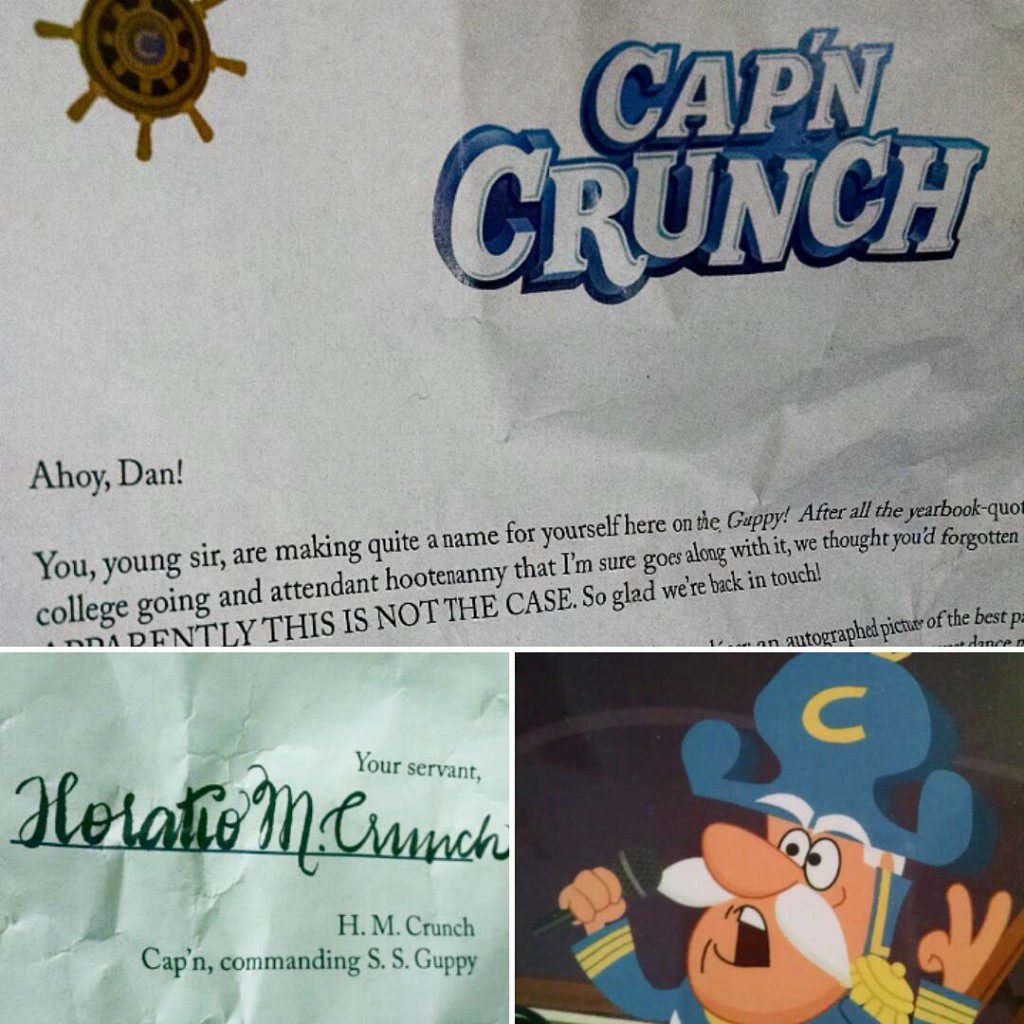
Someone onboard the S.S. Guppy knows what they’re doing, and I salute them for it. Remember when you were a kid coming home from school on Friday afternoon? You had a bounce in your step and plenty of optimism about the blissful and sugary sweet Saturday morning waiting ahead of you.
Cap’n Crunch remembers this feeling. And he knows that while people may grow up and markets may shift, sometimes change isn’t the solution.
Sometimes you just have to keep the magic alive.





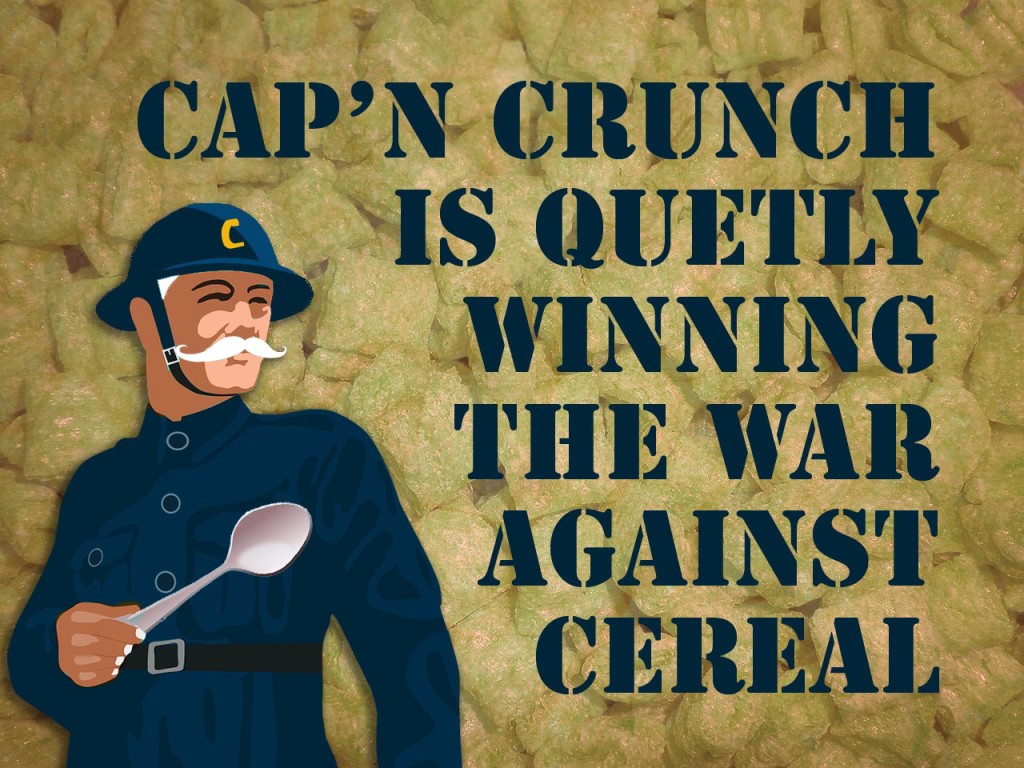
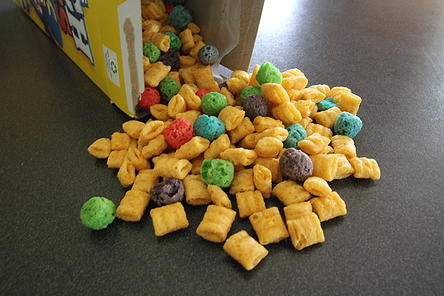
What are the artificial and natural flavours in the captain crunch berries?
What if they could use real sugar and natural coloring and still achieve the same final result as far as look and taste goes? That doesn’t make it perfect but it’s better than high fructose corn syrup and artificial coloring.
I like the open thoughts and taking a stance. While I do get nostalgic and want to see a lot of the things come back but I think the diversified options now offer a good change of pace as needed.
While it would be nice to still have sugar suckers like Kaboom but there are still fun cereals out there.
I work in marketing as well and I think the ball is being dropped in terms of cereal PR and the message needs to get back to freaking taste.
Appreciate this thought provoking read.
“Kellogg’s and General Mills need to use cereal as the nostalgic touchstone so many see it as, complete with zany colors, games on the back of the box, and hilarious exaggerated cartoon characters.”
I agree in once sense and disagree in another. I think you’re still being a tad selective. How is the Late Night Snack ad campaign not an appeal to nostalgia? Sure, if two 30 year olds are sitting in their kitchen and eating cereal with a few beers, then I can see it as an appeal to a guilty pleasure snack. But the thing is, the focus of that commercial is Super Mario. I think it’s much more a play for the memory of being a kid. That said, I get what you’re saying. Lucky the Leprechaun seems like he’s been taken out of the spotlight, and, certainly, much time and money has been devoted to advertising the healthy aspects of cereal to adults (primarily women).
It’s interesting, though, that you focus on the idea of a mascot and a story line to create a cultural myth. Honestly, this is an awesome thesis that could easily get you dissertation in sociology! To be honest, though, I think it a bit selective. I know Cap’n Crunch has done some mail-in type exchanges, but to my knowledge, Kelloggs and GM have both continued to include novelty items and to run similar box promotions.
I wish we as a society wouldn’t stigmatize this idea of advertising toward children. I mean as long as a parent can use decent judgement, kid’s should be able to assert some market influence what goes into their bodies. I think when you look at declining cereal sales, a lot may be driven by ageing millennials (who don’t have kids) and younger-ish parents who have become parents in the era of cereal = not healthy breakfast.
I don’t disagree that I’m being selective. Unfortunately, no matter how hard I try to dissociate, my writing will doubtlessly still be affected by the campaigns and moments that impacted my own childhood most strongly (there’s that cultural myth at work again). I just hope it doesn’t detract from the point I was going for in this piece.
And perhaps there was some error in my wording about Late Night Snack, as I agree with you; I included above as an example of a bright spot (how ironic) in Kellogg’s recent advertising, though the campaign has slowed in intensity recently.
As for the current state of cereal premiums and “lore,” it’s true that all cereal brands still dabble with in-box prizes and online campaigns, but I don’t see any of them mining their rich histories of characters and backstories quite like the Cap’n does. Maybe that’s just because Cap’n Crunch seemed to have more memorable characters to begin with (again, your mileage may vary).
It is a sad day when no one is allowed to advertise to kids any more. Cereal aside, I really miss Grimace. It’s interesting that you note this new generation of parents, though. It makes me wonder whether soon-to-be parents aged 20-35 are more likely to embrace the counter-cereal health movement, or whether they’ll think back to their happy childhoods and give their children the same.
I know which option I’d choose, and when I did, I’d head straight to Cap’n Crunch to buy my kid an edible textbook of preserved Cereal History.
Ugh. Don’t even get me started on how crappy Happy Meals have become. Good discussions, Dan. Lots to munch over while I’m snacking on some Cookie Crisp tonight.
First off, I love that you’re willing to dive into editorial content. While reviews of products are great, nothing beats pieces that broaden our perspective of the breakfast table and lead to substantial dialogue about the economics, culture, and whathaveyou of the cereal aisle.
That said, I can’t support your conclusion. The data just isn’t there, and if it is, I can’t find it. I used to work in a job that involved me pitching projects for funds to a group of marketing people, and, whenever the marketing manager could see that my excitement and arguments were based too much on intuition and negative evidence about other projects, she’d ask me to show her the numbers for why my project would be a success. Basically, the analogy is this: Do sales in the Cap’n Crunch brand show a higher rate of growth/slower rate of decline that comparable GM or Kellogg’s brands? That said, how can we adjust our comparisons to account for 3-4 Cap’n Crunch varieties against any given GM brands (perhaps the Chex brand would work, but not, say Trix…since there is only one Trix.)
Likewise, how do we account for Cap’n Crunch’s performance against other PepsiCo cereals such as Life, Oatmeal Squares, Real Medleys, etc.
I have my own suspicions on why cereal sales are down, but I haven’t the data to support it, and it involves looking more into cultural and socio-economic factors of the US population over time. Much depends on intuition about changing demographics related to lower birth rates of Caucasians, but like I said, it’s not something I have numbers for.
Anyways, this is all good stuff to ruminate on, and another reason that we need to start a cereal podcast!
You make good points, and I’ll be the first to admit that my thoughts here are based much more off of my informal ethnographic research while being steeped in “cereal culture” for a long time than in any sales figures.
I suppose I should qualify my statement about Cap’n Crunch “winning.” I consider it more of an ideological victory than a business one. While I have no qualms about the direction General Mills and Kellogg’s are moving, their approach is slowly changing cereal into something wholly different than it has been. It’s more of a slow acquiesce to cereal’s critics rather than a rebuttal.
Call me a nostalgia-blind, change-fearing cereal regressionist if you must, but I think through a little cultural strategy, Cap’n Crunch’s tendency to stick to his cereal blunderbusses and keep the tradition strong.
As an aspiring advertising copywriter, I know how important sales figures are as a bottom line, but I also understand the ability of “cultural myths” to cut through depersonalized marketing jargon. These myths look past the form utility of a product and into the deeper motivations and desires of the product’s audience—in my hypothesis, it’s the desire to feel perennially young in a world that’s growing up and growing serious far too fast.
I think Cap’n Crunch’s best days are still ahead of him. Due to media stigma, the brand has stopped advertising to kids (or at all, really) through traditional media. The Cap’n’s social presence is strong, but if he injects himself back into the lives of cereal consumers, he can draw them to the cereal aisle where that magnetic allure of childhood memory can finish the job.
This is all speculation of course, but here’s the bottom line I see: when the novelty of artificial colorless cereal runs out, will those brands still be able to maintain a loyal consumer tribe without the compelling animated narratives of old: the kind that Cap’n Crunch is still telling?
Regardless, I’m glad you liked my attempt at editorial work! 🙂